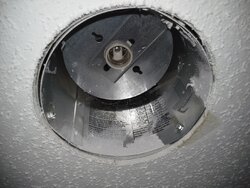I was always envious of you all saying your home was more evenly heated then mine, I was seeing on cold mornings under 25f over a 10 degree difference in temps between my living room and dining room in a small 1500sqft Cape, this morning it was the usual 59 degree's in my kitchen and almost 70 in the living room where the stove is.
My home was built in 1952, It was gutted in 2007/2008 and most walls and ceilings were replaced, before I bought it in june 2008, they added 7 recessed cans in my kitchen and what was a breezeway between the garage is now part of my living room, last week I replaced all my BR30 bulbs with LED Philip's bulbs that were onsale at HD, I knew for years that there was serious cold drafts coming from around the lights, I pulled off the rings and where they cut the holes there was some serious gaps and cold air was coming in, I caulked around the gaps and now it feel's alot warmer
.
My home was built in 1952, It was gutted in 2007/2008 and most walls and ceilings were replaced, before I bought it in june 2008, they added 7 recessed cans in my kitchen and what was a breezeway between the garage is now part of my living room, last week I replaced all my BR30 bulbs with LED Philip's bulbs that were onsale at HD, I knew for years that there was serious cold drafts coming from around the lights, I pulled off the rings and where they cut the holes there was some serious gaps and cold air was coming in, I caulked around the gaps and now it feel's alot warmer
.


